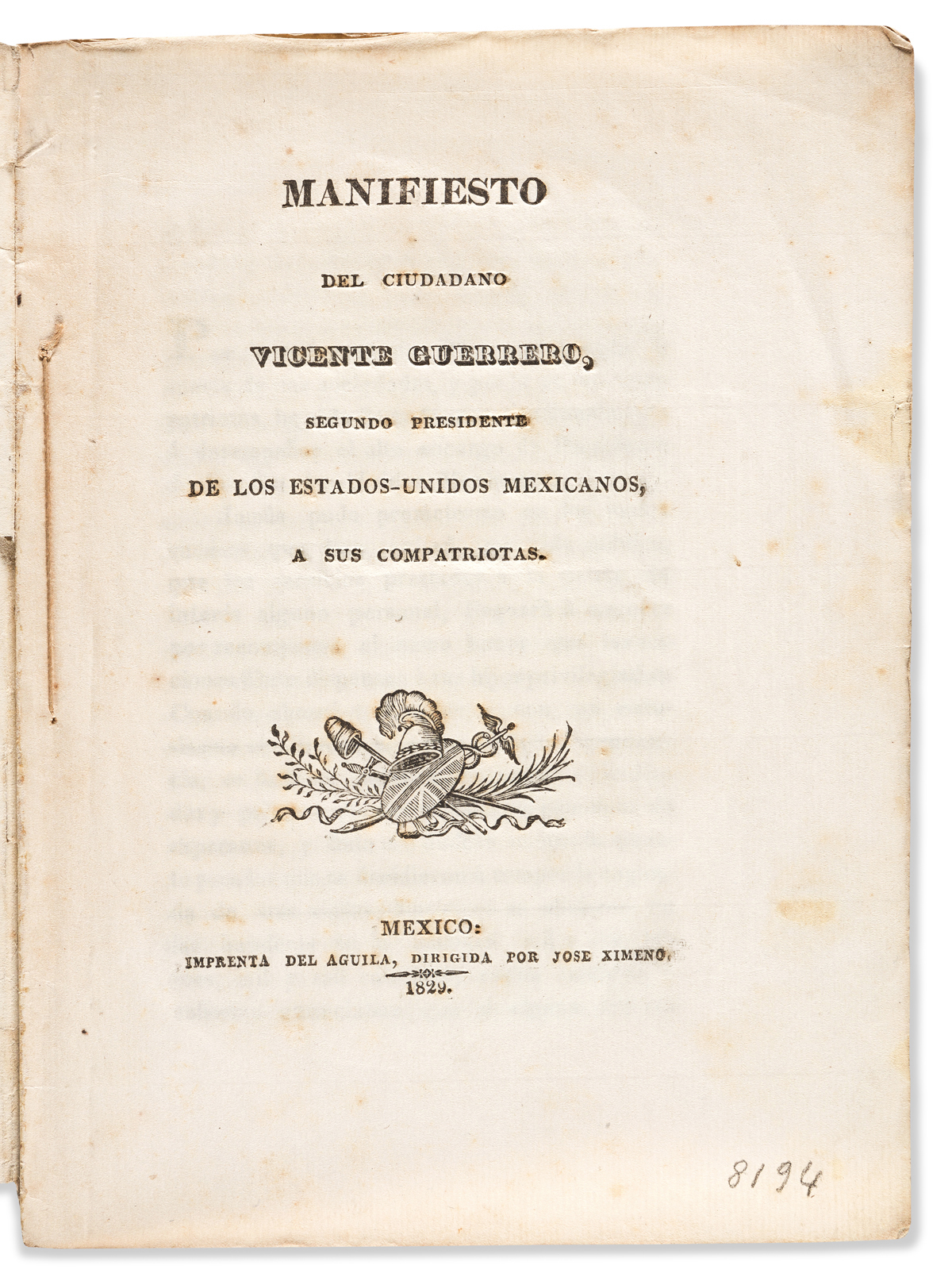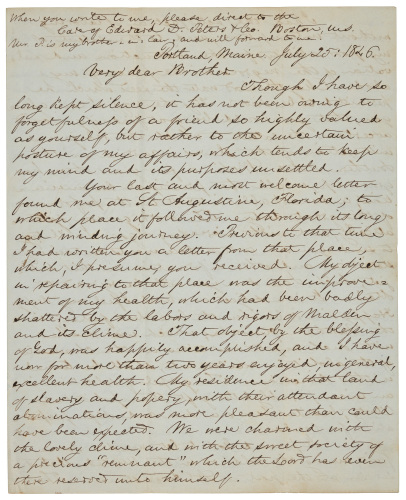(SLAVERY AND ABOLITION--MEXICO.) Group of slave sale agreements from colonial New Spain. 18 manuscript pages on 6 sheets, 12 1/2 x 8 1/2 inches; stitch holes, minor wear, uncut. Puebla, Mexico, 1670 and 1724
These documents can be described in three groups. First are 4 sale agreements on 2 conjoined sheets, all dated April 1670, describing the sale of Barbadian slaves to a priest. Domingo Grillo and the heirs of Ambrosio Lomelino were Genoese merchants who held the official license to import slaves into the port of Veracruz. They passed the slaves on to two Mexican dealers, Francisco Arias de Viveros and Sebastián de Velasco, who had a joint license to sell slaves in Puebla. Their client in all f ... These documents can be described in three groups. First are 4 sale agreements on 2 conjoined sheets, all dated April 1670, describing the sale of Barbadian slaves to a priest. Domingo Grillo and the heirs of Ambrosio Lomelino were Genoese merchants who held the official license to import slaves into the port of Veracruz. They passed the slaves on to two Mexican dealers, Francisco Arias de Viveros and Sebastián de Velasco, who had a joint license to sell slaves in Puebla. Their client in all four transactions was a priest from the village of Acatlán named Nicolás Soltero Castaneda, who may have purchased them to work on a church-owned mill or farm. The slaves were "bozales," African-born slaves, born in Angola, as they were said to have been of Arará ethnicity. They had been initially taken by Dutch slavers to English-controlled Barbados. Each were unbaptized young males and were sold for 415 gold pesos each. These complex arrangements demonstrate the global nature of the slave trade, spanning in this case five competing empires: Spanish, Genoese, Dutch, English, and Angolan. Next are a pair of sale agreements, also from April 1670, involving Juan Moreno and Juan Sánchez de Aldana, owner of a workshop. They are in verso and recto of a single leaf, with an unrelated document on a conjoined sheet. In the first, Moreno sold a 12-year-old mulatillo or "little mulatto" named José Criollo to Sánchez de Aldana. Young José Criollo, probably destined for a life of labor in the aforementioned workshop, fetched a price of 200 gold pesos. In the second sale, the roles were reversed, as Sánchez de Aldana sold a slave of his own, the 20-year-old mulatto Salvador, to Moreno for 300 gold pesos. Last is a bill of sale for the sale of a slave named María, dated 1 February 1724, on both sides of a page, clipped to two apparently unrelated documents. Juan Sánchez Frenero Trujillo of Puebla sold the 29-year-old slave to the widow doña Mariana Fernández de Mansilla of Morelos for 320 pesos. The widow was the owner of the hacienda San Gaspar, which had once been part of the estate of Martín Cortés (1532-1589), son of the conqueror of Mexico; it still exists today as an event venue in modern-day Morelos. As mentioned in the bill, San Gaspar included a sugar mill, where María may have been fated to work. The document mentions that María was married to another slave also owned by Sánchez, from whom she would presumably now be separated.
(SLAVERY AND ABOLITION--MEXICO.) Group of slave sale agreements from colonial New Spain. 18 manuscript pages on 6 sheets, 12 1/2 x 8 1/2 inches; stitch holes, minor wear, uncut. Puebla, Mexico, 1670 and 1724
These documents can be described in three groups. First are 4 sale agreements on 2 conjoined sheets, all dated April 1670, describing the sale of Barbadian slaves to a priest. Domingo Grillo and the heirs of Ambrosio Lomelino were Genoese merchants who held the official license to import slaves into the port of Veracruz. They passed the slaves on to two Mexican dealers, Francisco Arias de Viveros and Sebastián de Velasco, who had a joint license to sell slaves in Puebla. Their client in all f ... These documents can be described in three groups. First are 4 sale agreements on 2 conjoined sheets, all dated April 1670, describing the sale of Barbadian slaves to a priest. Domingo Grillo and the heirs of Ambrosio Lomelino were Genoese merchants who held the official license to import slaves into the port of Veracruz. They passed the slaves on to two Mexican dealers, Francisco Arias de Viveros and Sebastián de Velasco, who had a joint license to sell slaves in Puebla. Their client in all four transactions was a priest from the village of Acatlán named Nicolás Soltero Castaneda, who may have purchased them to work on a church-owned mill or farm. The slaves were "bozales," African-born slaves, born in Angola, as they were said to have been of Arará ethnicity. They had been initially taken by Dutch slavers to English-controlled Barbados. Each were unbaptized young males and were sold for 415 gold pesos each. These complex arrangements demonstrate the global nature of the slave trade, spanning in this case five competing empires: Spanish, Genoese, Dutch, English, and Angolan. Next are a pair of sale agreements, also from April 1670, involving Juan Moreno and Juan Sánchez de Aldana, owner of a workshop. They are in verso and recto of a single leaf, with an unrelated document on a conjoined sheet. In the first, Moreno sold a 12-year-old mulatillo or "little mulatto" named José Criollo to Sánchez de Aldana. Young José Criollo, probably destined for a life of labor in the aforementioned workshop, fetched a price of 200 gold pesos. In the second sale, the roles were reversed, as Sánchez de Aldana sold a slave of his own, the 20-year-old mulatto Salvador, to Moreno for 300 gold pesos. Last is a bill of sale for the sale of a slave named María, dated 1 February 1724, on both sides of a page, clipped to two apparently unrelated documents. Juan Sánchez Frenero Trujillo of Puebla sold the 29-year-old slave to the widow doña Mariana Fernández de Mansilla of Morelos for 320 pesos. The widow was the owner of the hacienda San Gaspar, which had once been part of the estate of Martín Cortés (1532-1589), son of the conqueror of Mexico; it still exists today as an event venue in modern-day Morelos. As mentioned in the bill, San Gaspar included a sugar mill, where María may have been fated to work. The document mentions that María was married to another slave also owned by Sánchez, from whom she would presumably now be separated.















Testen Sie LotSearch und seine Premium-Features 7 Tage - ohne Kosten!
Lassen Sie sich automatisch über neue Objekte in kommenden Auktionen benachrichtigen.
Suchauftrag anlegen